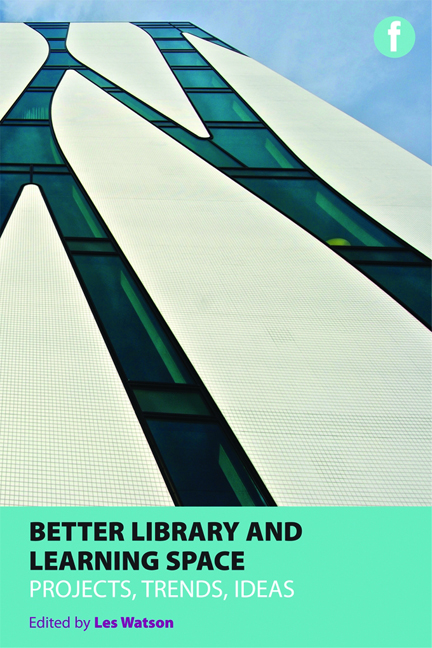Book contents
- Frontmatter
- Contents
- Case studies
- Acknowledgements
- Contributors
- Introduction – about this book
- PART 1 PROJECTS AND TRENDS
- PART 2 TRENDS AND IDEAS
- PART 3 IDEAS AND FUTURES
- Introduction
- 11 Beyond space: access is all – or is it?
- 12 Thinking inside the box
- 13 Nothing has changed/everything has changed – the enduring aspects of learning
- 14 Books, nooks and MOOCs
- 15 The researcher's view: context is critical
- 16 Libraries in the network society: evolution, revolution, extinction?
- 17 Powered by learning: developing models of provision to meet the expectations of new generations of students
- 18 The library has left the building
- 19 Beyond analogue: the learning studio as media-age library
- 20 3D libraries for 3D smarting
- 21 Learning landscapes, the library and the University of Lincoln: efficiency, effectiveness, expression and experimentation
- 22 Viral design: learners building better environments together
- 23 The interior designer's view
- 24 Furniture fit for the future – a brief exploration of library and learning furniture today and for the coming generation
- 25 Conclusions
- Index
20 - 3D libraries for 3D smarting
from PART 3 - IDEAS AND FUTURES
Published online by Cambridge University Press: 08 June 2018
- Frontmatter
- Contents
- Case studies
- Acknowledgements
- Contributors
- Introduction – about this book
- PART 1 PROJECTS AND TRENDS
- PART 2 TRENDS AND IDEAS
- PART 3 IDEAS AND FUTURES
- Introduction
- 11 Beyond space: access is all – or is it?
- 12 Thinking inside the box
- 13 Nothing has changed/everything has changed – the enduring aspects of learning
- 14 Books, nooks and MOOCs
- 15 The researcher's view: context is critical
- 16 Libraries in the network society: evolution, revolution, extinction?
- 17 Powered by learning: developing models of provision to meet the expectations of new generations of students
- 18 The library has left the building
- 19 Beyond analogue: the learning studio as media-age library
- 20 3D libraries for 3D smarting
- 21 Learning landscapes, the library and the University of Lincoln: efficiency, effectiveness, expression and experimentation
- 22 Viral design: learners building better environments together
- 23 The interior designer's view
- 24 Furniture fit for the future – a brief exploration of library and learning furniture today and for the coming generation
- 25 Conclusions
- Index
Summary
Unintended consequences; book-based learning creates sheep
During one of my meanders around the internet, I stumbled on the idea of unintended consequences. It made me realize how we've transformed so many talented people into passionless sheep. I'm convinced this transformation was not a conscious choice. Teachers, entrepreneurs and policy makers are eager to encourage others to do their work with passion and creativity, but these attributes seem scarce. Maybe this is an unintended consequence of trying too hard to achieve this. I think the lack of passion is a side effect of one of the biggest inventions in history, the printing press, and the resulting education system based on it. Book printing indirectly smothered our children's talents and passions like the wind blowing out a candle. The total absence of passion in our education system is the unintended consequence of the printing press.
In my book My Organisation is a Jungle (Staes, 2008), I recall history lessons in which I was fascinated by the timeline hanging above the blackboard. Each period was indicated on it with a name that identified that period. The Stone Age, the Bronze Age and the Iron Age. Time and again people were faced with new ideas and saw them as either a threat or an opportunity. What is happening today is no different, except that it's not the processing of iron or bronze but the processing of an overabundance of information sources. Companies and organizations that are most efficient and effective information processors come out on top and can respond rapidly to the emerging needs of a changing society. New and inspiring information is an important source of learning driving creative entrepreneurship and innovation. I see this chaotic period in which we now live and work as the fascinating but dramatic transformation from the 2D Age to the 3D Age (Figure 20.1). The flat, two-dimensional 2D Age, characterized by classroom learning, predictability and continuous improvement, is laboriously making way for the three-dimensional 3D Age. In the 3D Age more and more passionate talents will produce and exploit new information to drive innovation. The greatest barrier to entering the new 3D Age, however, are the invisible walls that 2D teachers and 2D managers have unconsciously erected around our passions and talents.
- Type
- Chapter
- Information
- Better Library and Learning SpaceProjects, trends and ideas, pp. 223 - 230Publisher: FacetPrint publication year: 2013



